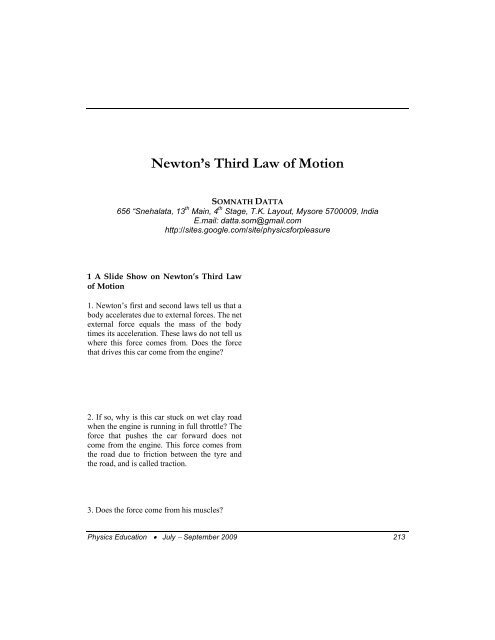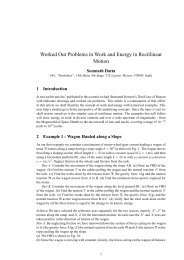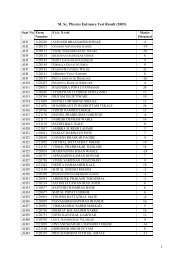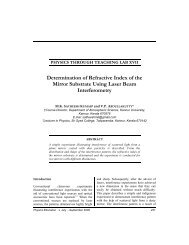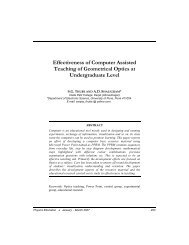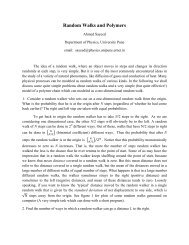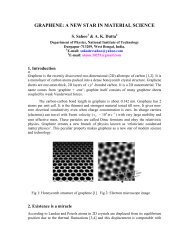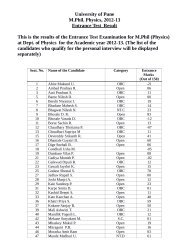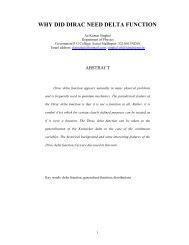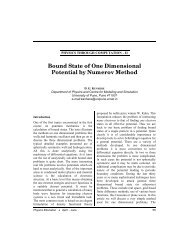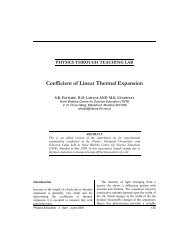Newton's Third Law of Motion
Newton's Third Law of Motion
Newton's Third Law of Motion
Create successful ePaper yourself
Turn your PDF publications into a flip-book with our unique Google optimized e-Paper software.
Newton’s <strong>Third</strong> <strong>Law</strong> <strong>of</strong> <strong>Motion</strong><br />
SOMNATH DATTA<br />
656 “Snehalata, 13 th Main, 4 th Stage, T.K. Layout, Mysore 5700009, India<br />
E.mail: datta.som@gmail.com<br />
http://sites.google.com/site/physicsforpleasure<br />
1 A Slide Show on Newton’s <strong>Third</strong> <strong>Law</strong><br />
<strong>of</strong> <strong>Motion</strong><br />
1. Newton’s first and second laws tell us that a<br />
body accelerates due to external forces. The net<br />
external force equals the mass <strong>of</strong> the body<br />
times its acceleration. These laws do not tell us<br />
where this force comes from. Does the force<br />
that drives this car come from the engine?<br />
2. If so, why is this car stuck on wet clay road<br />
when the engine is running in full throttle? The<br />
force that pushes the car forward does not<br />
come from the engine. This force comes from<br />
the road due to friction between the tyre and<br />
the road, and is called traction.<br />
3. Does the force come from his muscles?<br />
Physics Education • July − September 2009 213
4. If so, why is he slipping? No runner is his<br />
able to run on a slippery track in spite <strong>of</strong> his<br />
muscle power. The force that drives the runner<br />
forward comes from the ground when there is<br />
sufficient friction between his feet and the<br />
ground.<br />
5. This car requires 40,000 N to speed up at the<br />
rate <strong>of</strong> 10m/s 2 . This sprinter requires 300 N to<br />
speed up at the rate <strong>of</strong> 5m/s 2 . How is the road<br />
able to judge the individual force requirements<br />
for the car and the sprinter?<br />
6. Answer to this comes from Newton’s <strong>Third</strong><br />
<strong>Law</strong> <strong>of</strong> <strong>Motion</strong>:<br />
• Nothing in the universe can act without<br />
being acted upon.<br />
• To every action there is an equal and<br />
opposite reaction.<br />
The first statement is somewhat<br />
philosophical. The second one is vague. In<br />
exact terms what the first statement means is<br />
that whenever any object A <strong>of</strong>fers a force F, it<br />
itself experiences the same force back on itself<br />
in the reverse direction.<br />
214 Physics Education • July − September 2009
7. The second statement can be interpreted as<br />
follows. Assume two objects A and B. A <strong>of</strong>fers<br />
a force on B directed from A to B. We denote<br />
this force by F AB . The 3rd <strong>Law</strong> says B will<br />
simultaneously <strong>of</strong>fer a force F BA on A which is<br />
directed from B to A. These two forces are<br />
equal and opposite, even if the objects A and B<br />
are grossly unequal in size and mass. Written<br />
as vectors,<br />
F BA = −F AB . (1)<br />
We can refer to any one <strong>of</strong> the pair <strong>of</strong> forces,<br />
say the force F AB , as the action force and the<br />
second one, i.e. F BA , as the reaction force.<br />
Then Eq. (1) is a mathematical expression <strong>of</strong><br />
the second statement.<br />
In the particular example shown these two<br />
forces are repulsive forces.<br />
8. Here they are attractive forces. A pulls B<br />
with a force F AB . As a result A is itself being<br />
pulled towards B with a force F BA , and F BA =<br />
−F AB .<br />
9. A runner can run only if the ground kicks<br />
him forward. To get this kick the runner must<br />
kick the ground backward. It is possible to kick<br />
a solid and firm object like football or grass<br />
with sufficient force, but it is difficult to kick a<br />
loose object like air or slippery road with<br />
sufficient force. Therefore the runner is unable<br />
to run on a slippery road.<br />
Physics Education • July − September 2009 215
10. It is possible to get the necessary force <strong>of</strong><br />
40,000 N from a dry ground because the tyre,<br />
powered by the engine, can press against the<br />
road with this force due to friction between the<br />
two surfaces (<strong>of</strong> the tyre and the ground.) A<br />
frictionless surface on the other hand will not<br />
allow the tyre to rub with a large force and<br />
because <strong>of</strong> this the car will not be able to<br />
accelerate.<br />
11. There is a common misconception about<br />
the <strong>Third</strong> <strong>Law</strong> especially among the beginners.<br />
They think that this law holds only when the<br />
interacting bodies are in equilibrium since the<br />
forces <strong>of</strong> action and reaction will then cancel<br />
each other. This is entirely wrong. Here we<br />
show two bodies A and B.<br />
12. But the force F AB is acting on B only.<br />
Therefore B is not in equilibrium.<br />
13. The reaction force F BA is acting on A only.<br />
Therefore A is not in equilibrium.<br />
216 Physics Education • July − September 2009
14. Now see the complete picture. The forces<br />
are equal and opposite. But they do not cancel<br />
each other. Because they are acting on different<br />
bodies.<br />
15. We see that the third law holds between<br />
any two bodies, whether at rest or in motion.<br />
16. Let us illustrate the <strong>Third</strong> <strong>Law</strong> with a few<br />
more examples. This stone <strong>of</strong> mass 1 kg is<br />
falling to the ground in a parabolic trajectory<br />
with acceleration g equal to 9.81 m/s 2 , like any<br />
other stone. The gravitational pull on the stone<br />
is m times g, that is, 9.81 N. Since the earth is<br />
pulling the stone with force 9.81 N downward,<br />
the stone is at the same time pulling the earth<br />
with a force <strong>of</strong> the same magnitude <strong>of</strong> 9.81 N,<br />
but directed upward.<br />
17. Therefore the earth is also accelerating<br />
toward the stone! However, since the mass <strong>of</strong><br />
the earth is very LARGE, its acceleration<br />
(toward the stone) is very small.<br />
Physics Education • July − September 2009 217
18. Another example: A football player kicks a<br />
football. Therefore according to the 3rd <strong>Law</strong>,<br />
the football kicks the player back.<br />
19. The kick is an impulsive force, lasting for a<br />
very short time, say, 1 <strong>of</strong> a second. Taking<br />
10<br />
the mass <strong>of</strong> the ball to be ¼ kg, we have<br />
calculated the kick force to be 250 N.<br />
20. The 3rd <strong>Law</strong> tells us that the ball also kicks<br />
the player back in the opposite direction.<br />
However, since the mass <strong>of</strong> the player is 100<br />
kg, i.e., 400 times the mass <strong>of</strong> the ball, his<br />
acceleration is 400 times less and lasts exactly<br />
for 1<br />
10 second.<br />
21. Here we see the complete picture. The<br />
mutual kick forces are equal and opposite. But<br />
they do not cancel each other, because they act<br />
on different bodies.<br />
218 Physics Education • July − September 2009
22. Let us try to understand how this horse is<br />
able to pull the cart.<br />
23. The cart requires a force <strong>of</strong> 2500 N to<br />
accelerate. But there is a backward frictional<br />
drag on the wheels. Therefore the horse must<br />
pull the cart with a force <strong>of</strong> 3000 N.<br />
24. The horse needs 1500 N to accelerate.<br />
According to the 3rd <strong>Law</strong>, the cart is pulling<br />
horse back with force 3000 N. Therefore the<br />
ground must provide the necessary traction<br />
force <strong>of</strong> 4500 N in the forward direction.<br />
25. How does the horse get this 4500 N<br />
traction force? By pressing against the ground<br />
with this force, according to the 3rd <strong>Law</strong>. Also<br />
since the wheels are experiencing frictional<br />
drag <strong>of</strong> 500 N backward, the ground is at the<br />
same time dragged forward with 500 N, again<br />
due to the 3rd <strong>Law</strong>. The resulting acceleration<br />
<strong>of</strong> the ground is very small, since the mass <strong>of</strong><br />
the earth is very LARGE.<br />
Physics Education • July − September 2009 219
26. Now see the complete picture. For every<br />
force there is an equal and opposite reaction<br />
force. But the forces on any one <strong>of</strong> the three<br />
bodies are not in equilibrium. Therefore, the<br />
cart, the horse and the ground are all<br />
accelerating (though in different degrees).<br />
27. As final example we consider the motion <strong>of</strong><br />
the earth and the moon due to the gravitational<br />
attraction between the two. Note the distance<br />
between the centres <strong>of</strong> the earth and the moon,<br />
and the masses <strong>of</strong> the earth and the moon. The<br />
gravitational force with which the earth is<br />
pulling the moon is 20.6 × 10 19 N.<br />
28. As a result the moon is accelerating toward<br />
the earth and is moving in a circle.<br />
29. The earth is experiencing a force <strong>of</strong> exactly<br />
the same magnitude <strong>of</strong> 20.6 × 10 19 N but<br />
directed toward the moon. However, the mass<br />
<strong>of</strong> the earth is about 83 times the mass <strong>of</strong> the<br />
moon. Therefore the earth is undergoing a<br />
much smaller acceleration <strong>of</strong> 3.44 × 10 −5 m/s 2 .<br />
As a result the centre <strong>of</strong> the earth is also<br />
moving in a circle, a much smaller circle.<br />
220 Physics Education • July − September 2009
30. Both the moon and the earth are<br />
accelerating toward each other according to the<br />
<strong>Third</strong> <strong>Law</strong> <strong>of</strong> <strong>Motion</strong>. The centre <strong>of</strong> each is<br />
moving in a circle, one circle being much<br />
larger than the other because one mass is much<br />
smaller than the other.<br />
2 Free Body Diagrams<br />
Newton’s first law <strong>of</strong> motion is difficult to<br />
believe. Why should anyone believe that an<br />
object keeps moving forever along a straight<br />
line in the absence <strong>of</strong> external interferences,<br />
when our everyday encounters seem to<br />
contradict the statement?<br />
Similarly Newton’s third law <strong>of</strong> motion is<br />
rarely believed. It is easy to “imagine” equal<br />
and opposite action-reaction forces when, for<br />
example, a stone is resting on a table. But how<br />
to trust the same statement when the table<br />
breaks and the stone crashes down?<br />
The confusion is understandable, and<br />
persists. The reason − our apathy to explain the<br />
theory properly with effective drawings. For<br />
understanding concepts and principles <strong>of</strong><br />
mechanics drawing freebody diagrams is an<br />
essential first step. Without this Newton’s laws<br />
<strong>of</strong> motion can never be appreciated.<br />
2.1 What is a Freebody Diagram?<br />
A freebody diagram (FBD) is a pictorial<br />
formulation <strong>of</strong> the mechanics problem through<br />
figures in which each object in a system <strong>of</strong><br />
interacting bodies is shown separately and the<br />
forces acting on this body (and on this body<br />
alone) are clearly delineated and also shown<br />
separately. The slides presented in the previous<br />
section have shown many examples <strong>of</strong> FBDs.<br />
Some <strong>of</strong> the important ones are the following<br />
• A runner and the ground in Slide 9 (The<br />
gravity force has been suppressed);<br />
• A car and the ground in Slide 10;<br />
• A falling stone and the earth in Slides 16-<br />
17;<br />
• A football player, football and the ground<br />
in Slides 19- 21;<br />
• A cart, a horse pulling it, and the ground in<br />
Slides 23-26;<br />
• The earth and the moon in Slides 27-29.<br />
2.2 The Golden Rules for Understanding<br />
Newton’s <strong>Law</strong>s <strong>of</strong> <strong>Motion</strong><br />
For understanding Newton’s laws <strong>of</strong> motion<br />
properly, especially their applications to<br />
extended objects, it is essential that the<br />
following golden rules be kept in mind.<br />
1. Clearly identify the “system” whose<br />
motion you are going to analyze.<br />
Sometimes it may be useful to draw a<br />
boundary around this system in order to<br />
identify it and isolate it from all<br />
neighbouring systems.<br />
2. All the forces that are coming from outside<br />
this system you have just identified − by<br />
this I mean the forces that are coming from<br />
outside the boundary you have drawn - are<br />
to be called external forces. Forces <strong>of</strong><br />
“interaction” among objects inside the<br />
system that is, forces coming from objects<br />
that are confined within the boundary you<br />
have drawn − are all internal forces.<br />
3. Therefore draw a freebody diagram (FBD)<br />
<strong>of</strong> all the external forces. You must<br />
remember that FBDs are a must for<br />
understanding mechanics. It is impossible<br />
Physics Education • July − September 2009 221
to appreciate the principles <strong>of</strong> mechanics,<br />
the forces and how they guide the motion<br />
<strong>of</strong> objects, without drawing FBDs.<br />
4. Add up vectorially all the external forces<br />
acting on the system. In some cases this<br />
vector sum may be zero. In that case a<br />
central point <strong>of</strong> the object, called the<br />
Centre <strong>of</strong> Mass, to be abbreviated as CM,<br />
will be either stationary or moving with<br />
constant velocity (i.e., constant speed<br />
along a straight line.)<br />
We shall refer to the motion <strong>of</strong> the CM as<br />
the bulk translatory motion <strong>of</strong> the system.<br />
If the vector sum <strong>of</strong> the external forces is<br />
non-zero, then that vector sum F total will be<br />
called the Resultant Force on the system.<br />
The bulk translatory motion <strong>of</strong> the system<br />
is determined by Newton’s second law <strong>of</strong><br />
motion, which can now be written as<br />
M r = F total (2)<br />
where M is the total mass <strong>of</strong> all the component<br />
parts <strong>of</strong> the system, and r is the radius vector <strong>of</strong><br />
the CM <strong>of</strong> the system, so that r is the<br />
acceleration <strong>of</strong> the CM.<br />
We have illustrated Rules 1,2,3 in Figures<br />
1. In the Top Box we have shown three objects<br />
A, B and C interacting with one another, and<br />
forming a system. We assume that this system<br />
<strong>of</strong> three objects is not subjected to any<br />
“external force”. Individually the objects A, B<br />
and C are moving and accelerating only due to<br />
the forces <strong>of</strong> interaction among themselves.<br />
In frame (a) we have depicted each one <strong>of</strong><br />
them as a single system, by drawing<br />
boundaries (with dotted lines) around each.<br />
The forces <strong>of</strong> interaction are (F 1 ,F′ 1 ), (F 2 ,F′ 2 ),<br />
(F 3 ,F′ 3 ). The pair <strong>of</strong> forces within parentheses<br />
are the “equal and opposite” action-reaction<br />
pairs. For example if F′ 1 is the action force,<br />
then its counterpart F 1 is the corresponding<br />
(equal and opposite) reaction force. Similarly if<br />
F 3 is the action force, then its counterpart F′ 3 is<br />
the corresponding (equal and opposite) reaction<br />
force. Note also that we have drawn “shooting”<br />
lines on each one <strong>of</strong> the three objects indicating<br />
that the objects are all moving objects having<br />
velocities v a , v b , v c respectively.<br />
Each one <strong>of</strong> the three systems A,B,C is<br />
subjected to the following external forces:<br />
(1) external forces F 1 ,F 2 on A;<br />
(2) external forces F′ 1 ,F′ 3 on B;<br />
(3) external forces F′ 2 ,F 3 on C.<br />
In frame (b) we have clubbed A and B<br />
forming a single system AB. Now it is an<br />
interaction between two systems namely, AB<br />
and C. The only external force on AB is F′, and<br />
the only external force on C is F = −F′.<br />
In frame (c) we have taken A, B and C<br />
together as a single system ABC. There are no<br />
external forces on this system ABC.<br />
We shall now illustrate Rule 4 in the form<br />
<strong>of</strong> the following equations <strong>of</strong> motion.<br />
System Net external force on the system Eqn <strong>of</strong> <strong>Motion</strong><br />
A F total = F 1 + F 2 m a ra<br />
= F1 + F 2<br />
B F total = F′ 1 + F′ 3 m b<br />
rb<br />
= F′ 1 + F′ 3<br />
C F total = F′ 2 + F 3 m c rc<br />
= F′ 2 + F 3<br />
AB F total = −F = −(F′ 2 +F 3 ) = F 2 + F′ 3 (m a +m b ) r ab<br />
= F′=−F<br />
ABC F total = 0 (m a +m b +m c ) r abc<br />
=0<br />
(3)<br />
222 Physics Education • July − September 2009
Figure 1. Forces <strong>of</strong> interaction between systems <strong>of</strong> material objects.<br />
In the above table m a ,m b ,m c represent the<br />
masses <strong>of</strong> the systems A, B, C respectively,<br />
and r a , r b , r c , r ab , r abc represent the locations <strong>of</strong><br />
CMs <strong>of</strong> the systems A, B, C, AB, ABC<br />
respectively.<br />
In the Bottom Box <strong>of</strong> Figure 1 we have<br />
shown a stone falling under the force <strong>of</strong><br />
gravity. The bulk motion <strong>of</strong> the stone is<br />
determined by the gravity force mg. We had<br />
shown an FBD <strong>of</strong> this object in slide 16 <strong>of</strong> the<br />
previous section. However, we have repeated<br />
the FBD in frame (a).<br />
The stone is composed <strong>of</strong> a large number <strong>of</strong><br />
atoms, <strong>of</strong> the order <strong>of</strong>, say, 10 25 . These atoms<br />
are pulling or pushing each other. Yet, they are<br />
all internal forces and, therefore, have no effect<br />
on the bulk motion <strong>of</strong> the stone.<br />
Now, “imagine” a boundary line Σ dividing<br />
the stone into parts A and B, which we shall<br />
refer to as A-stone and B-stone respectively.<br />
Then there are action-reaction forces (F,F′)<br />
between the two parts, which are always equal<br />
and opposite. We have shown the FBD <strong>of</strong> both<br />
the parts in frame (b). The CM <strong>of</strong> A-stone is<br />
moving under the effect <strong>of</strong> (1) the gravity force<br />
m a g, and (2) the force F on it coming from B.<br />
These two forces cause the falling <strong>of</strong> the A-<br />
stone under gravity, along with rotational<br />
motion <strong>of</strong> the CM. 1<br />
In the same manner the CM <strong>of</strong> the B-stone<br />
is moving under the effect <strong>of</strong> (1) the gravity<br />
force m b g, and (2) the reaction force F′ = −F on<br />
it coming from A. These two forces together<br />
cause the falling under gravity along with<br />
rotation <strong>of</strong> the CM <strong>of</strong> B.<br />
We shall now apply Rule 4 to the falling<br />
stone and its two parts and obtain the following<br />
equations <strong>of</strong> motion.<br />
1. There can also be oscillatory motion <strong>of</strong> the CMs<br />
<strong>of</strong> A and B, due to vibration induced by the forces F<br />
and F′ respectively.<br />
Physics Education • July − September 2009 223
System Net external force on the system Eqn <strong>of</strong> <strong>Motion</strong><br />
Whole stone F total = Mg M r = Mg<br />
A-stone F total =m a g+ F m a r a = m a g+F<br />
B-stone F total = m b g − F m b r b = m b g+F′ = m b g−F<br />
(4)<br />
In the above table (M = m a + m b , r), (m a ,<br />
r a ), (m b , r b ) represent (mass, location <strong>of</strong> the<br />
CM) <strong>of</strong> the whole stone, A-stone, B-stone<br />
respectively.<br />
The reader should note here an important<br />
point. The only external force on the whole<br />
stone is the gravitational force. Hence the point<br />
C (representing the CM <strong>of</strong> the stone) falls in a<br />
parabolic path like an ordinary projectile. On<br />
the other hand A-stone and B-stone are<br />
subjected to extra forces F and −F<br />
respectively, besides the force <strong>of</strong> gravity. Their<br />
CMs C a and C b follow “nonparabolic” paths.<br />
3 Further Examples <strong>of</strong> FBDs<br />
In Figures 2-5 we have cited a number <strong>of</strong><br />
instances in which the third law presents us<br />
with a paradox. We have illustrated graphically<br />
each situation by identifying the forces with<br />
FBDs, and in two cases listing them in a<br />
tabular form. This, we hope, will facilitate<br />
clarification <strong>of</strong> the Second and the <strong>Third</strong> <strong>Law</strong>s<br />
<strong>of</strong> <strong>Motion</strong>.<br />
We have presented in Tables 1 and 2 the<br />
“Forces at Work” corresponding to two <strong>of</strong> the<br />
examples cited, namely, (a) Diving, and (b)<br />
Tug <strong>of</strong> War. In the right column <strong>of</strong> each table<br />
you will see the forces on the subsystems. The<br />
action-reaction forces on these subsystems<br />
taken together add up to zero, so that the net<br />
force on the “Total” system is nil.<br />
In writing the vectors in Table 2 we have<br />
taken the forces T 1 ,T 2 ,F 1 ,F 2 to be in the<br />
direction <strong>of</strong> the positive X axis (i.e.,<br />
rightward), and the forces N 1 ,N 2 ,M 1 g,M 2 g to be<br />
in the direction <strong>of</strong> the positive Z axis (i.e.,<br />
upward).<br />
4 Every Real Force has a Parent<br />
Newton’s first law <strong>of</strong> motion gives a<br />
qualitative meaning <strong>of</strong> force. A force is<br />
something which makes a particle, a system,<br />
deviate from its “most natural” motion,<br />
namely, moving in a straight line with constant<br />
velocity. The second law pinpoints the concept<br />
further by painting force in the colour <strong>of</strong> a<br />
vector, a directed straight line with a specified<br />
length − equal to the rate <strong>of</strong> change <strong>of</strong><br />
momentum <strong>of</strong> the object. The third law refines<br />
the concept <strong>of</strong> force further by making the<br />
grand statement, “force is an interaction<br />
between two objects in which each one is<br />
equal.”<br />
The earth pulls a mosquito with the same<br />
force with which the mosquito pulls the earth.<br />
A proton pulls an electron with the same force<br />
with which the electron (about two thousand<br />
times lighter) pulls the proton. These<br />
statements are as pr<strong>of</strong>ound as the shock and<br />
disbelief they generate in our minds. Yet the<br />
statements are true.<br />
However, the reader must not miss a crucial<br />
assumption in the statements <strong>of</strong> the laws <strong>of</strong><br />
motion. Velocity, momentum, acceleration are<br />
frame dependent quantities. They have no<br />
meaning unless you have specified a frame <strong>of</strong><br />
reference. What frame? The frame in which the<br />
statements are valid.<br />
That reads like the old joke: which came<br />
first, the egg or the chicken?<br />
However, the assumption <strong>of</strong> an inertial<br />
frame is not an absurdity. The concept <strong>of</strong> a<br />
family <strong>of</strong> inertial frames (the name <strong>of</strong> the<br />
frames in which the laws <strong>of</strong> motion hold) lies<br />
at the foundation <strong>of</strong> classical mechanics.<br />
224 Physics Education • July − September 2009
Figure 2: Free body diagrams <strong>of</strong> diving. The action-reaction pair <strong>of</strong> forces are shown with the same<br />
roman bold letter appearing twice, once with prime and once again without it. The forces at play are<br />
the tension forces (T,T′) between the board and the left pillar; the compressive (pressure) forces<br />
(P,P′) between the board and the left pillar; the force R′ with which the diver kicks the board and the<br />
kickback reaction force R he receives, the gravitational forces (G 1 ,G′ 1 ), (G 2 ,G′ 2 ), (G 3 ,G′ 3 ), (G 4 ,G′ 4 ).<br />
Drawings on Left show Normal Diving. Drawings on Right show accident in diving. The board gets<br />
uprooted from one <strong>of</strong> the supporting pillars, and the diver tumbles into the water. In this case the<br />
pair <strong>of</strong> forces T,T′ disappear, and they disappear simultaneously.<br />
Physics Education • July − September 2009 225
Figure 3. We have now written each pair <strong>of</strong> action reaction forces with the same symbol (even<br />
though they have opposite signs.) For example (T 1 ,T 1 ) are action-reaction forces <strong>of</strong> tension. Top :<br />
Tug <strong>of</strong> War. Note that the tension forces T 1 ,T 2 are not equal in magnitude, because the rope has<br />
considerable mass m and it is accelerating. The contestant on the right is pushing the ground with<br />
friction force F 1 , and a downward force N 1 , and at the same time pulling the earth upward with a<br />
gravitational force M 1 g. The earth is repaying him back with the same force in opposite direction.<br />
Bottom : Boy jumping <strong>of</strong>f a boat. In Figure (b) we have shown the forces acting on the “boat + boy”<br />
system. Figures (c) and (d) show the FBDs <strong>of</strong> the boat and the boy separately. We have removed<br />
the earth from our “system”.<br />
226 Physics Education • July − September 2009
Figure 4. Top: FBD <strong>of</strong> an unfortunate man who is sinking into a quicksand. He sinks because the<br />
gravitational force downward is larger in magnitude than the upward reaction force provided by the<br />
ground. We have not shown the action-reaction counterpart <strong>of</strong> this gravitational force (pulling the<br />
earth upward.) Bottom : Action-reaction forces between a balloon and the escaping gas. We have<br />
marked out a rectangular column <strong>of</strong> the gas which is pushed downward with a gas-pressure force<br />
<strong>of</strong> magnitude F 1 . This causes an upward reaction force <strong>of</strong> the same magnitude acting on the<br />
balloon. The balloon accelerates upward because this reaction force F 1 is larger than the weight <strong>of</strong><br />
the balloon (same as the downward force <strong>of</strong> gravity on it. The lateral pressure forces F 2 , F 3 , F 4 , F 5<br />
are balanced causing no sidewise acceleration <strong>of</strong> the gas. Their reaction counterparts are similarly<br />
balanced causing no sidewise acceleration <strong>of</strong> the balloon.<br />
Physics Education • July − September 2009 227
Figure 5. A locomotive steam engine hauling a train consisting <strong>of</strong> only two coaches. We assume<br />
that the train is moving with constant speed, so that the net force on the train is zero. (a) General<br />
picture. The train is moving from right to left as indicated by the arrow at the front and by the<br />
direction in which the Driving Wheels are turning. (b) FBD <strong>of</strong> the engine and the coaches. Note that<br />
the driving wheels, connected to the piston (reciprocating inside the steam chamber), shown as a<br />
box) by the connecting rod, are pressing the rails backward thereby getting the traction force F t ,<br />
directed forward. It is this traction force that moves the train. The other wheels are subjected to<br />
rolling frictions F r1 ,F r2 ,F r3 ,F r4 , directed backward, and trying to slow down the train. T 1 ,T 2 are<br />
tensions in the chains that connect the engine to coach 1, and coach 1 to coach 2 respectively. (c)<br />
FBD <strong>of</strong> the whole train. (d) FBD <strong>of</strong> the rails. We have suppressed the gravity forces. In the boxes<br />
we have indicated the force equalities. When the train accelerates, the equality symbol “=”<br />
becomes “greater than” symbol “>”.<br />
228 Physics Education • July − September 2009
Table 1. Forces at work in diving<br />
System External force on the system<br />
Diver R+G 1<br />
Diving board<br />
T+G 2 +P+R′<br />
Left pillar T′+G 4<br />
Right pillar P′+G 3<br />
Earth G′ 1 +G′ 2 +G′ 3 +G′ 4<br />
Total 0<br />
(5)<br />
Table 2. Forces at work in tug <strong>of</strong> war<br />
System Net external force on the system<br />
Player-right<br />
−T 1 +F 1 +N 1 −M 1 g<br />
Player-left<br />
T 2 −F 2 +N 2 −M 2 g<br />
Rope T 1 −T 2<br />
Earth<br />
−F 1 +F 2 −N 1 −N 2 +M 1 g+M 2 g<br />
Total 0<br />
(6)<br />
Anyone who applies Newton’s laws <strong>of</strong><br />
motion must be standing in an inertial frame.<br />
The space capsule in which the modern day<br />
heroes − the astronauts − are floating is the best<br />
example <strong>of</strong> an inertial frame. In contrast, the<br />
earth is not.<br />
What are the forces acting on a missile shot<br />
out from an earth station? Along with the main<br />
force, the force <strong>of</strong> gravity, there are other<br />
forces, the centrifugal force and the Coriolis<br />
force. These “other forces” are not forces <strong>of</strong><br />
interaction. And Newton’s third law <strong>of</strong> motion<br />
does not apply to them.<br />
Imagine yourself sitting in a fast<br />
accelerating train (better still imagine yourself<br />
sitting inside a jet plane as it accelerates along<br />
the runway before taking <strong>of</strong>f.) You feel as if<br />
someone is pushing you backward, against the<br />
chair in which you are sitting. Let us refer to<br />
such forces as force type l.<br />
Think <strong>of</strong> another sensation. You are on a<br />
rotating platform <strong>of</strong> a merry −go-round − your<br />
first stop on entering a carnival park. If you are<br />
sitting on a chair on the go-round, you feel that<br />
someone is trying to throw you outward, away<br />
from the centre, but the chair is saving you<br />
from such disaster. Even stranger will be your<br />
feeling if you try to walk on the platform.<br />
Besides the outward “throw out” force, called<br />
the centrifugal force, you will also feel a<br />
“transverse force” (i.e. perpendicular to the<br />
direction you are walking in) making you feel<br />
dizzy. This sideward force is called Coriolis<br />
force. Let us refer to these two forces as force<br />
types 2 and 3)<br />
The force types 1,2 and 3, are not forces <strong>of</strong><br />
action-reaction. They completely disappear<br />
when the platform you are on (train, aeroplane,<br />
merry-go-round) comes to a stop. People club<br />
such forces under fancy names : fictitious<br />
forces, pseudo-forces.<br />
The pseudo forces are clearly distinct from<br />
the real forces.<br />
All real forces have parents. They originate<br />
from some material source, and reach out to<br />
other material objects altering their motions in<br />
accordance with Newton’s laws.<br />
In contrast, the pseudo-forces do not have<br />
parents, i.e., they do not originate from<br />
material sources. We mistake them to be forces<br />
Physics Education • July − September 2009 229
ecause we are always thinking our frames to<br />
be inertial even when they are not.<br />
Physicists do not feel shy <strong>of</strong> applying<br />
Newton’s laws <strong>of</strong> motion even when sitting in<br />
noninertial frames. They make up for their<br />
errors by inventing the fictitious pseudo-forces.<br />
5 Mach’s Principle<br />
Pseudo-forces are not as untouchable, bereft <strong>of</strong><br />
respectability, as their category may indicate.<br />
They have a trail <strong>of</strong> glorious history. It was<br />
Ernst Mach’s deep insight that brought<br />
pseud<strong>of</strong>orces on par with real forces by<br />
suggesting that the pseudo-forces originate<br />
from the mighty galaxies <strong>of</strong> an accelerating<br />
universe (when your frame is accelerating with<br />
respect to an inertial frame, the universe is also<br />
accelerating backward with respect to your<br />
frame.) Albert Einstein was so influenced by<br />
this pr<strong>of</strong>ound message that he removed all<br />
distinctions between inertial and non-inertial<br />
frames and proposed a theory <strong>of</strong> gravitation in<br />
which pseudo-forces are no different from<br />
gravitational forces.<br />
Acknowledgment<br />
The author gratefully acknowledges the help<br />
provided by Michael Murphy and Pr<strong>of</strong>essor<br />
A.V. Gopala Rao help in installing Linux for<br />
preparation <strong>of</strong> the manuscript.<br />
References<br />
There is one full chapter (18 pages long) on FBDs,<br />
with a wide variety <strong>of</strong> examples and illustrated<br />
drawings in the following book which the author<br />
found in the “References” <strong>of</strong> the article “Friction” in<br />
Wikipedia. http://en.wikipedia.org/wiki/Friction.<br />
1. Andy Ruina, Rudra Pratap, Introduction to<br />
Statics and Dynamics, Pre-print for Oxford<br />
Univ Press, January 2002.<br />
Books on engineering mechanics usually contain<br />
many examples <strong>of</strong> FBDs. See for example the<br />
following book.<br />
2. F.P. Beer, E.R. Johnston, Vector Mechanics for<br />
Engineers, McGraw Hill, N.Y. (1962).<br />
Rolling friction and traction forces are well<br />
explained in<br />
3. A.N. Mateev, Mechanics and Theory <strong>of</strong><br />
Relativity, Mir Publishers, Moscow (1989).<br />
The drawings in this article were all drawn by the<br />
author. In particular the drawings appearing in<br />
Section 1 (Slide Show) and the drawings appearing<br />
in Fig. 2 were published in this journal in 1986.<br />
4. S. Datta, A Film Strip on Newton’s <strong>Third</strong> <strong>Law</strong><br />
<strong>of</strong> <strong>Motion</strong>, Physics Education, Vol 2, No. 4<br />
(January-March 1986), pp 30-40.<br />
The drawings appearing in Figures 3 and 4 were<br />
part <strong>of</strong> a Teacher’s Guide handwritten by the author<br />
in December 1989 at Kavaratti, capital <strong>of</strong><br />
Lakshadweep islands, as part <strong>of</strong> a teacher training<br />
programme organized by the Regional College <strong>of</strong><br />
Education (NCERT), Mysore.<br />
230 Physics Education • July − September 2009


